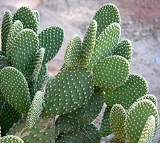
Opuntia microdasys
Encyclopedia
Opuntia microdasys is a species of cactus
native and endemic to central and northern Mexico
.
40–60 cm tall, occasionally more, composed of pad-like stems 6–15 cm long and 4–12 cm broad.
Opuntia microdasys has no spines, but instead has numerous white or yellow glochid
s 2–3 mm long in dense clusters; these detach very easily on being touched, and can cause considerable skin irritation, so the plants must be treated with caution. Despite this, it is a very popular cactus in cultivation.
. Some botanists treat the two as a single species.
Cactus
A cactus is a member of the plant family Cactaceae. Their distinctive appearance is a result of adaptations to conserve water in dry and/or hot environments. In most species, the stem has evolved to become photosynthetic and succulent, while the leaves have evolved into spines...
native and endemic to central and northern Mexico
Mexico
The United Mexican States , commonly known as Mexico , is a federal constitutional republic in North America. It is bordered on the north by the United States; on the south and west by the Pacific Ocean; on the southeast by Guatemala, Belize, and the Caribbean Sea; and on the east by the Gulf of...
.
Description
Opuntia microdasys forms a dense shrubShrub
A shrub or bush is distinguished from a tree by its multiple stems and shorter height, usually under 5–6 m tall. A large number of plants may become either shrubs or trees, depending on the growing conditions they experience...
40–60 cm tall, occasionally more, composed of pad-like stems 6–15 cm long and 4–12 cm broad.
Opuntia microdasys has no spines, but instead has numerous white or yellow glochid
Glochid
Glochids are hair-like spines or short prickles, generally barbed, found on the areoles of cacti in the sub-family Opuntioideae. Cactus glochids easily detach from the plant and lodge in the skin, causing irritation upon contact...
s 2–3 mm long in dense clusters; these detach very easily on being touched, and can cause considerable skin irritation, so the plants must be treated with caution. Despite this, it is a very popular cactus in cultivation.
Related species
The very closely related Opuntia rufida differs in having reddish-brown glochids; it occurs further north in northern Mexico, and into western TexasTexas
Texas is the second largest U.S. state by both area and population, and the largest state by area in the contiguous United States.The name, based on the Caddo word "Tejas" meaning "friends" or "allies", was applied by the Spanish to the Caddo themselves and to the region of their settlement in...
. Some botanists treat the two as a single species.

